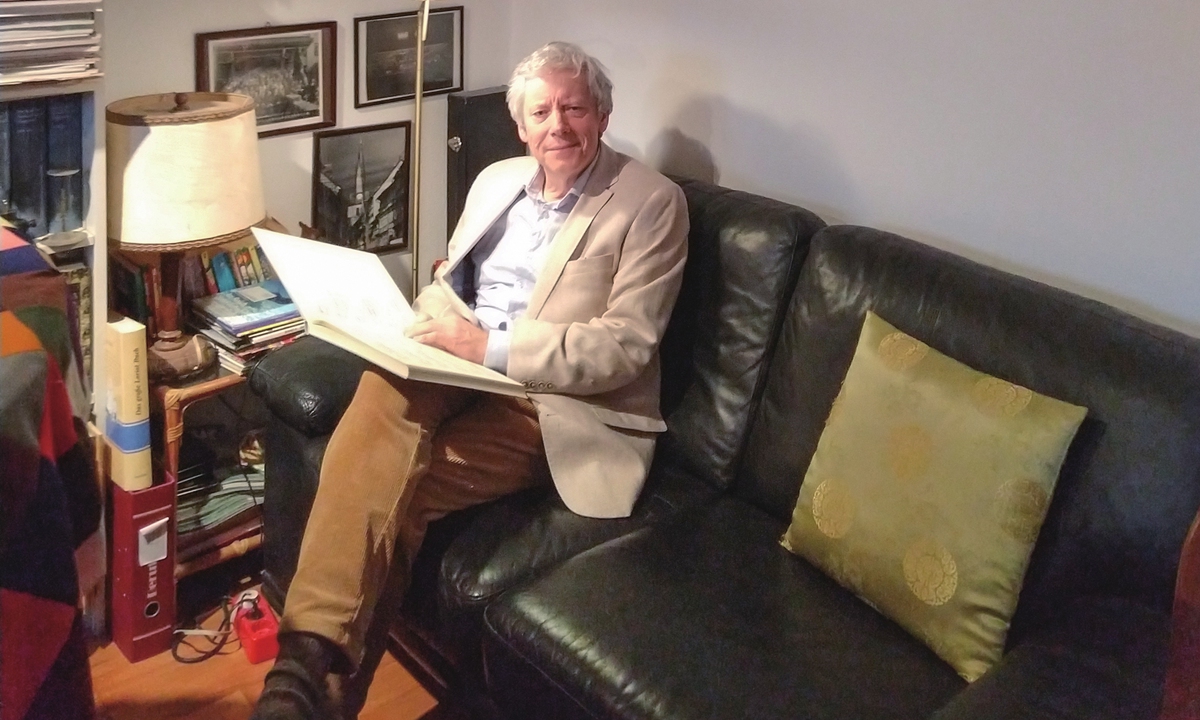ARTS / CULTURE & LEISURE
Appreciating Debussy’s ‘Moonlight’ through Li Bai’s poem ‘Invitation to Wine’
Connected romanticism

Andreas Stier at his home in Hamburg, Germany Photo: Courtesy of Stier
After a 40-year career as a piano professor at the University of Music and Theatre Hamburg, in Germany, Andreas Stier now has a "second identity": a popular influencer on Chinese social media thanks to his eloquent and attractive classical music instructional videos done in fluent Chinese.
In one of his latest videos, he tells the story of Franz Schubert, sitting at a Steinway in his Hamburg house, with a window behind him framing colorful leaves dancing in the wind.
He introduces the master of the early romantic era through his waltz composition. To make it more relatable to his Chinese fans, he compares Schubert's waltz to ancient Chinese beauties Pan An and Xi Shi, who are said to have been the most handsome man and the most gorgeous woman respectively in Chinese history.
"Imagine there are 'two lines' of Pan An and Xi Shi facing each other… but they keep stumbling because of the restless note."
For him, playing piano should be fun and soothing.
"Music helps you find inner peace and beauty that balance your busy life. It is something you can enjoy only by slowing yourself down. And I hope these videos I post will be my way of giving back to Chinese society," Stier said in a video interview with the Global Times.
Double identity
Besides teaching, Stier has also worked as a part-time Chinese translator in his free time.
The pianist told the Global Times that he was exposed to culture from China since he was a little boy. However, he didn't have the chance to learn the language until he traveled to Asia after he grew up.
But it was only three years ago that his son persuaded him to start building a fanbase on social media.
"I used to keep these two skills very separate. I never spoke Chinese in my class, nor talked about music in Chinese. But since my classes were reduced after COVID-19, I thought it would be a good opportunity to combine the two most important interests in my life," Stier said.
He started on YouTube, where many pianists and classical music lovers were impressed by his piano technique, engaging narration, beautiful window view, and relaxed lifestyle.
"A US fan told me that many fans on the Chinese mainland loved my videos and wondered if I could start an account on a Chinese social media platform, like Bilibili. So I did."
His son and a student manage the two social media accounts while Stier focuses on the content.
"I just enjoy watching Andy's video whenever I felt stressful, and it will always calm me down while learning some more stories that I never heard of in my piano career," said a netizen in his comment section, where his fans kindly call him "Teacher Andy."
His videos range from the nature-inspired Claude Debussy to the talented Baroque composer George Frideric Handel. He talks about stories of the lovesick Ludwig van Beethoven and the conflicted Johannes Brahms.
Sometimes he uses Chinese references to explain the artistic expression behind those masterpieces.
To describe the late autumn scenery, Stier uses phrases such as "swan geese fly south in grain rain," which were often used by ancient Chinese poets to elicit an autumnal mood, to convey the feelings of Pyotr Ilyich Tchaikovsky in his piece "The Seasons, Op. 37: X. October Autumn Song."
When introducing Debussy's "Moonlight," the nature in the piece reminded Stier of Li Bai, the ancient poet in China's Tang Dynasty(618-907) and his famous work Invitation to Wine, which begins with "The Yellow River surges down from heaven; It tumbles and flows into the sea."
"This is also one of my favorite ancient Chinese poems so far," said the 71-year-old pianist, "and you can always find a connection between traditional Chinese culture and Western classical music."
"Just like Chinese calligraphy," he pointed at the copies bought in China hanging on the wall.
Chinese calligraphy requires great skill, precision, and attention to detail. And the same is true if one takes a look at the technique of playing the violin, he explained, adding that cultures can be connected.
Language promotes music
The link that connected Stier to Chinese culture came from a special game - Mahjong - in which he spotted Chinese characters on the small tiles used in the game when he was little.
From watching family members playing Mahjong at Christmas to Chinese pottery artworks placed in the study at home, all of these memories and experiences drew Stier to Chinese culture. But born in a small town, he didn't have many opportunities to experience authentic Chinese culture.
Stier recalled his childhood interest in classical Chinese novels to the Global Times. "I was fascinated by the Outlaws of the Marsh, and I cried over the Dream of the Red Chamber plot."
He started his career as a Chinese translator after traveling to numerous cities in China.
"I learned Korean at first, but wasn't good at it. And I feel that Chinese is easier for me to learn."
After years of observation, Stier talked about what he thinks is the key to learning piano.
"Learning piano seems to have been a trend in China. There are many Chinese students in my school. When they come, it not only gives us a chance to share Western classical music, but it is also a good opportunity to enhance cultural understanding between China and the Western countries."
But no matter where his student is from, Stier emphasizes the power of interest in learning. In his videos, one can see his interpretation of nature from time to time: Spring flowers blossom in the home garden and vegetation grows in the forest near home, places where he finds inspiration for music.
Through making his videos, Stier wanted to feel like one of his fans in China. "Music contains our common morality as human beings. It includes an appreciation of humanities and nature, and love for family. We can find a lot of common ground through these exchanges."

